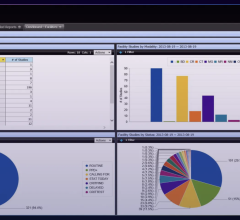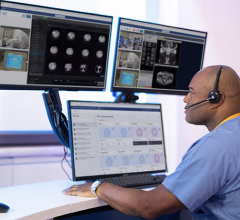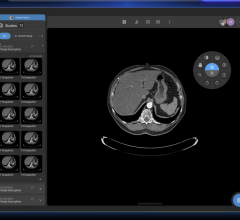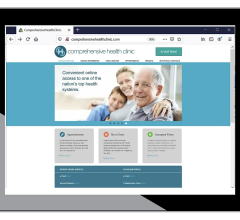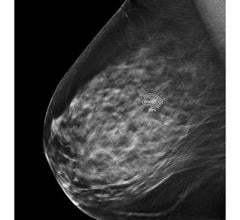
Anand Lalaji, M.D., is CEO of The Radiology Group Ltd.
“If you’re not getting better every day, then you’re falling behind” said Anand Lalaji, M.D., CEO of The Radiology Group Ltd. (TRG), LLC in Duluth, GA. Given the firm’s rapid growth, clearly Dr. Lalaji and his innovative remote reading team practice what they preach. Supported by their technology partner Neurostar Solutions Inc. — which has provided a unique and highly effective remote image reading and storage platform that, according to Dr. Lalaji, also gets better everyday — the firm is well positioned for ongoing expansion.
“Today’s radiology shortage has had an impact on small rural hospitals, in particular, which find it difficult to recruit and maintain radiology staff,” said the business savvy radiologist. Like many entrepreneurial practices, TRG jumped in to fill the gap — but not with your typical solution.
“We don’t provide just a teleradiology service for general radiology exam reading and off hours coverage,” he said. “Often, we deliver a virtual full-service department that provides a complete range of specialty interpretations, dictation and final reports and even insurance billing.” A key part of the firm’s mission is bringing academic-quality services to rural locations. The end result for the hospital is better and faster radiology services at lower cost.
This remote specialized reading, often delivered in cooperation with an onsite radiologist, is the model of the future, believes Dr. Lalaji, noting that frequently TRG either serves as a complete virtual staff or complements a single over-burdened in-house radiologist. With the blessing of the hospital, the business-minded practice at times will hire the site’s radiologist to join their firm. As part of a larger pool of radiologists, the doctor generally enjoys better hours and a more flexible working arrangement.
“It’s a win-win situation all around, “ Dr. Lalaji noted. “Hospitals are not in the business of running radiology groups. We relieve them of employment costs such as vacation time and health insurance, deliver enhanced services and lower department expenses overall.”
TRG reads for 16 facilities, ranging from 16 to 350 beds, in multiple states. They provide both general and sub-specialty interpretation that includes orthopedics, neuroradiology, mammography, complex body imaging and much more, along with general body imaging. To support this, the practice needs to have easy, reliable communications with facilities and referring physicians as well as with their staff wherever located.
Given that, Dr. Lalaji believes that the most significant advantage of today’s digital radiology technology is not the elimination of film but the enhancement of communications that will enable this virtual radiology department model. “How you integrate and network the technology is the most significant challenge of a digital conversion,” he said. “Neurostar shares our vision of using technology to maximize this communication. In fact, their unique Virtual Radiology Network (VRN) solution was really created with this in mind.”
Dr. Lalaji points out that Neurostar’s unique platform provides ultra-fast image access across multiple facilities. A thin-client image management, communication and archiving solution, the VRN downloads from a central server bank. It is
customizable so that wherever radiologists work, they can access the same familiar digital environment. The VRN relies on the Internet to provide connectivity among multiple locations, making it easy to install and extremely cost effective. Central to the solution is Neurostar’s offsite data center, which provides storage with multiple levels of redundancy. TRG uses this to provide streamlined anywhere, any time image access.
For TRG, the VRN seamlessly integrates images and reports from multiple locations to deliver a fully integrated high-throughput virtual radiology reading room, with full control over report turnaround times and distribution to referring doctors.
For both traditional report dictation and activation of templating, integrated speech recognition eliminates manual transcription cost and delays, adding significant efficiency. Physicians carry notebook computers and use docking stations onsite at facilities so that they can utilize their voice recognition profiles even while roaming.
Dynamic auto-routing based on a full range of parameters identifies the users’ current location and speeds the appropriate images to them. The solution is ideal for physicians who rotate among multiple facilities. Comprehensive individual user worklists include studies assigned through multiple client facilities that are automatically updated, helping keep workflow on track. Additionally, Study Life Cycle Management enables tracking of turnaround times (TATs) on a per-study basis and prioritizes each worklist based on the group’s commitments to various clients. Finally, workload balancing tools ensure that the reading is optimally split among the group.
“Adding to the appeal, Neurostar offers an affordable ASP model for use of the application and for digital exam storage,” he said. “That makes it particularly easy to track charges and pass them along to clients, many of whom have elected to use the Neurostar for data center for permanent image storage.” For clients that already have a PACS in place, the VRN can integrate with a site’s existing PACS to support remote image communications as well as off-site disaster recovery (DR) and business continuity.
Because of its Internet-based architecture, the Neurostar solution uses a minimum of hardware and is simple to install. “This makes it extremely easy for us to add new clients,” noted Dr. Lalaji. “They simply plug in a VRN Gateway, available as an integrated ‘black box’ or a Web-based software download, and they’re up-and-running.”
Dr. Lalaji paints a picture of what he believes to be the future of radiology, and his vision shapes TRG’s business plan today. “In the future, location will be truly irrelevant. Every hospital will offer patients the benefits of fast, specialized diagnoses through a group of sub-specialists who operate virtually just as we do today,” he said. “At many hospitals, general reading will continue to be handled by onsite radiologists, providing an anchor for the department, while small, rural facilities may have an entire virtual staff.”
This demands much of technology, Dr. Lalaji points out, noting that Neurostar’s VRN measures up to the challenge. “The decision to go with Neurostar was made carefully. Their vision is perfectly aligned with ours,” he said. “If we find we need a new feature to support our practice as it grows, they immediately address this. As a team, we’re both working to enhance our performance every day.”




 November 19, 2024
November 19, 2024 

